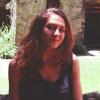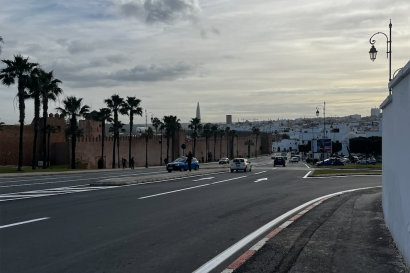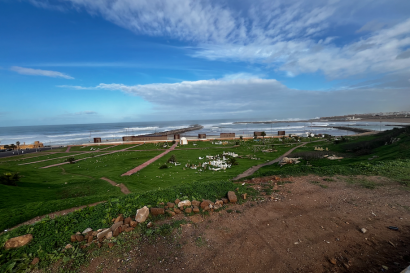In Morocco, the big dipper is upside-down. Like it might spill soup all over the night sky. I've been here now for three months, but occasionally, I notice new differences like that—quiet, sudden reminders that I am far from home. It slips my mind, sometimes.
Last week, in what was by far the program's most extravagant excursion, we were all shipped off to Merzouga, a town far in the south, where the Sahara Desert creeps across Morocco's border with Algeria. We drove for twelve hours to get there, the diversity of Morocco's terrain unspooling before us. Olive groves became grand pine forests became sunbeaten cliff faces. Then the mountains shriveled into plateaus. We were in the Saharan steppes.
The night sky of the Sahara, unspoiled by light pollution, teems with stars. We all lay in the sand the first night to gaze at the Milky Way and the backwards constellations.
Like I said, I often forget the distance that separates me and my home, my life there—an ocean and a continent. But when you are walking through the Erg Chebbi dunes, where all that you can see before you are swells of persimmon orange sand, where sound carries so that you can carry on a conversation with a friend half a football field away as if they were at your shoulder, where the sky is this ancient, endless blue—when you are walking there, the distance from home is palpable.
If you Google "Sahara Desert," the images that bob up are, often, taken at the Erg Chebbi sand dunes, near Merzouga. You've seen them: Camel trains walking at sunset, silhouetted. Sand dunes stretching into oblivion. Our van pulled up to the dunes and we blinked at the place in disbelief. It was like a movie set. It has been a movie set, actually. A Bond movie was shot there (as were some scenes from Sex and the City 2).
In reality, most of the Sahara is uglier and more brutal. It's barren plateaus and gravel plains. In a way, donning scarves to ride camels at Erg Chebbi, just minutes from our hotel, was like playing dress-up.
Later, after tiptoeing out from the hotel back into the dunes at night to gaze at the stars, like swarms of silver insects in the blackness, I decided that was unfair. At night in Erg Chebbi, the sky is near-indistinguishable from the dunes. A profound quiet blankets everything. Nothing is artificial about that place. It wasn't forged for a film.
A few days later, back in Rabat, I was walking back to my house from the beach. The route runs along the edge of the ocean past the famed Kasbah of the Oudayas, which sits on a hill. From the Kasbah, you can see the sunset over the water, beside an ancient, overgrown cemetery and a lighthouse. Turn the other way and the city stretches out before you, pale pink and cream.
At the Kasbah that day, I saw a stretch of trailers parked at the edge of the road, in place of the usual tour buses. I walked up to them to poke around, curious. They were fancy—a door propped open revealed faux-marble tiling and decorative plants in one. Another was full of camera equipment.
It was all for a movie, it turned out—American, but Moroccan-directed. I'd gone home to another film set. What absurd luck I've had to live in one.

Katya Schwenk
<p>I'm at junior at Georgetown, studying government, creative writing, and Arabic. I grew up in Vermont and Massachusetts. Interests include (but are not limited to!) radio, poetry, hiking, and beekeeping.</p>








